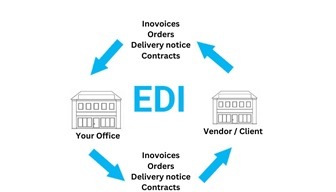
Understanding the difference between EDI and DEX protocols
In the digital transformation era we are living in, two acronyms often come up: EDI (Electronic Data Interchange) and DEX. While both concepts relate to data exchange, they serve distinct purposes and cater to different aspects of business operations. In a recent article, I explained what DEX is and why big retailers are enforcing its use. In this article, I will explain the differences between EDI and DEX, their functionalities and benefits.
Electronic Data Interchange (EDI)
EDI refers to the structured exchange of business documents between computer systems in a standardized format. It has been a cornerstone of B2B communication for several decades. EDI streamlines the transmission of business documents such as purchase orders, invoices, and shipping notices between trading partners. The data is formatted using specific message standards, like ANSI X12 or EDIFACT, ensuring compatibility across different systems. The figure below illustrates the concept.

Key Features of EDI
There are four features that characterize EDI applications.
Standardization: EDI relies on predefined message formats and protocols, enabling seamless communication between diverse systems.
Document-Centric Approach: EDI focuses on the exchange of business documents, ensuring accurate and efficient data transfer.
Trading Partner Integration: EDI fosters strong integration between business partners, establishing a reliable and automated data exchange process.
Compliance and Security: EDI frameworks offer built-in security measures and adherence to regulatory standards, ensuring data confidentiality and integrity.
Direct Store Delivery Digital Experience Exchange (DSD DEX)
DEX is an EDI standard that specifically addresses the unique requirements of the retail industry, particularly in scenarios involving direct store delivery. It enables real-time data exchange between suppliers and retailers, enhancing operational efficiency, inventory management, and customer experiences. DSD companies are being forced by the large retailers to use DEX to create and deliver the orders. DEX leverages APIs (Application Programming Interfaces) to facilitate real-time data exchange, enabling seamless integration across various systems and channels.
Key Features of DEX
Real-Time Data Exchange: DSD DEX enables suppliers to provide real-time updates on product availability, pricing, promotions, and delivery schedules to retailers, ensuring accurate and timely information.
Order Fulfillment and Inventory Management: DSD DEX facilitates automated order processing and inventory management, optimizing stock levels and reducing out-of-stock situations.
Improved Collaboration: DEX promotes seamless collaboration between suppliers and retailers, enhancing communication and reducing manual errors in order placement and fulfillment.
Differentiating EDI and DEX
While EDI and DEX both involve data exchange, they cater to different aspects of business operations. These are the main differences.
- Focus: EDI is a general framework for business document exchange, while DSD DEX specifically caters to the requirements of retail industry supply chain operations, emphasizing direct store delivery and real-time data exchange.
- Retail-Specific Functionality: DSD DEX provides features tailored to retail environments, including real-time inventory updates, order management, and integration with point-of-sale systems, which are not intrinsic to traditional EDI.
- Real-Time Data Flow: DSD DEX facilitates immediate data exchange, ensuring that suppliers and retailers have access to up-to-date information, promoting agile decision-making and operational efficiency.
- Retail Experiences: DSD DEX empowers retailers to enhance in-store operations, optimize product availability, and deliver exceptional customer experiences, whereas EDI primarily focuses on standardized data exchange.
I hope this article about EDI and DEX has been helpful to you. I will continue to post information related to warehouse management, distribution practices and trends, and the economy in general. If you want to know how Laceup’s solution can help you to successfully manage your inventory, click the link below to schedule an exploratory meeting.
There is a lot of relevant information on our channel. Check out this video on that explains plainly the difference between EDI and DEX.


Sorry, the comment form is closed at this time.